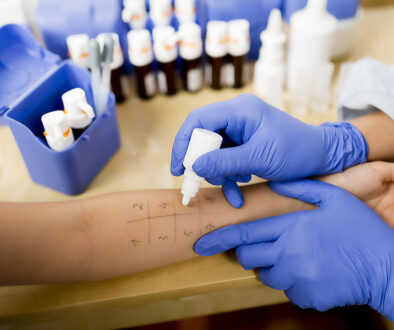What is Allergy Skin Testing and How Can It Help You?
Did a runny nose keep you from going on that weekend hike? Perhaps a scratchy throat or watery eyes put a damper on your vacation. Seasonal allergies are not only an inconvenience, but they also keep you from enjoying the activities you love. Often, relief means spending the rest of your life relying on over-the-counter medications. If this sounds familiar, the good news is there’s hope. Through allergy testing, your ear, nose and throat physician learns more about your specific allergy and is able to develop a customized plan for you.
WHAT IS ALLERGY SKIN TESTING?
Allergic reactions occur when your immune system goes into “overdrive” and reacts to certain substances called allergens. Some of the most common allergens include pollen, pet dander, dust mites and mold. When your body encounters them, it produces histamine, which causes the classic “hay fever” symptoms of sneezing, watery eyes, sore throat and stuffy nose.
Allergy skin testing is one of the tools your ENT doctor uses to determine what may be causing your allergies. He or she may use an intradermal test, where your skin is exposed to a diluted dose of the suspected allergens. If you are allergic, your skin will react with swelling, redness and possibly even small hives.
Depending upon the type of skin test, it may take up to two hours to administer. Often, the results are available in less than 30 minutes. You will be tested for different types of allergies at the same time. There are different types of allergy skin testing, and your ENT will determine which method is best for you.
Allergy testing also helps your ENT determine a safe dosage for beginning immunotherapy. Immunotherapy is a treatment that allows your body to build up a natural resistance to allergens and can eliminate the need to take medicine year-round.
THE BENEFITS OF ALLERGY SKIN TESTING
There are several ways that allergy skin testing can help you:
- It provides efficient treatment.
Knowing the exact cause of your problems enables your ENT to determine the best course of treatment, whether that means prescription medication or immunotherapy.
- It provides practical information.
Have you ever avoided adopting a pet because you thought you were allergic to pet dander? You may discover that the substances you thought were causing your allergies actually weren’t. Using this information, you’ll be able to take practical steps to enhance your medical treatment. For example, if you are allergic to pollen, you can avoid going outside when the pollen count is high.
- It can enhance the quality of your life.
Most patients are amazed by the dramatic improvement in their symptoms once an effective course of treatment has begun. Relief from allergy symptoms means fewer days are missed from school or work, and it often means returning to the outdoor activities you once enjoyed.
- It helps you know how to improve your environment.
Do you have any idea what may be lurking in that old carpet? What about your mattress cover? Once you discover what you’re allergic to, you can work with your ENT to implement effective environmental control measures that will go a long way toward your overall health. For example, if allergy testing reveals that dust mites are causing your problems, then you should get rid of old pillowcases, mattress covers, and even purchase mite-resistant bedding. Other possible strategies involve identifying and eliminating sources of mold.
TREATING ALLERGIES
Allergy skin testing produces accurate, measurable results that give your ENT a strategic plan to help you resolve your allergy problems in a way that is safe and effective. There are several different methods, and your physician will work with you to tailor a plan that is suited to you. Treatment methods include:
- Immunotherapy
Through this method, your body is gradually exposed to the source of your allergies, enabling it to build up a natural resistance that continues long after the treatment stops. This is called subcutaneous immunotherapy, which is administered by injecting small amounts of a serum to desensitize your body. You may have heard of this method referred to as “allergy shots.” - Sublingual immunotherapy (SLIT)
This treatment method uses the same principles—it exposes your body to diluted amounts of the allergen to build natural resistance. The difference is that SLIT does not require shots. Instead, drops are held under the tongue for two minutes and then swallowed. It is safe, convenient, and is a wonderful option for children or adults who are uncomfortable around needles.




